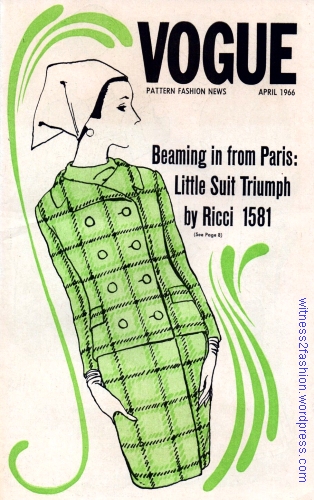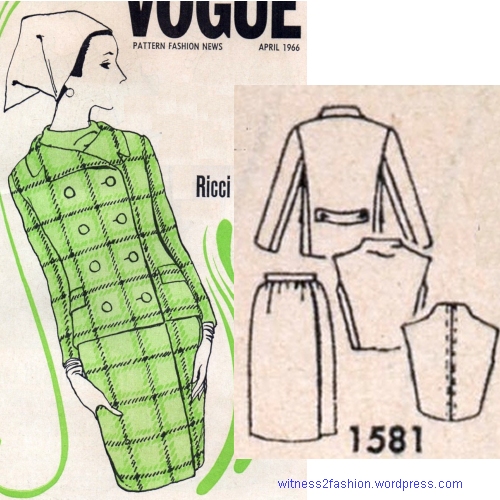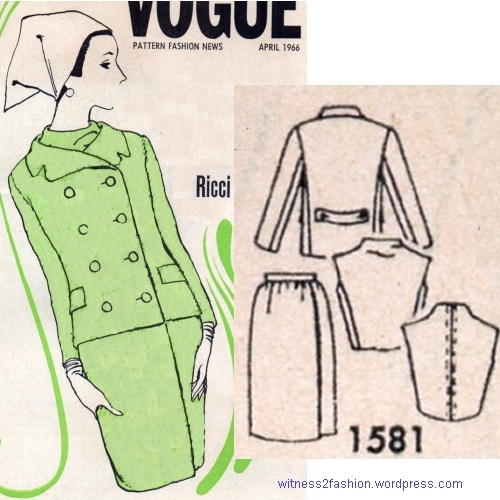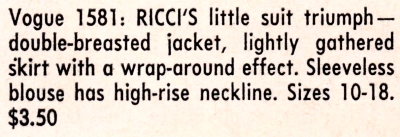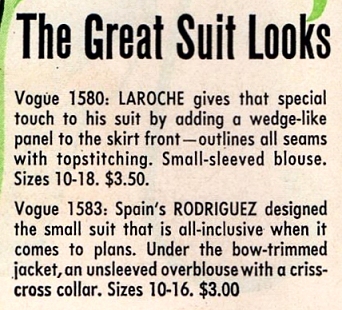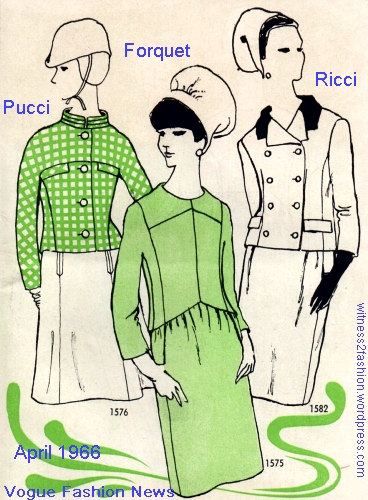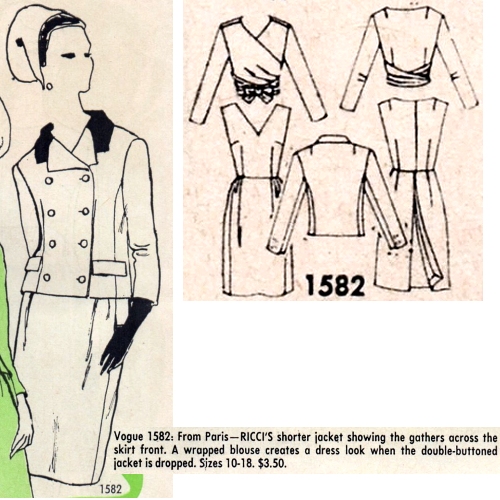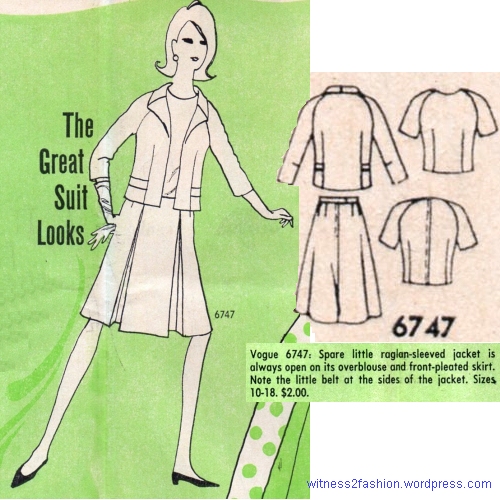I came across this Vogue Pattern Fashion News flyer for April, 1966, which interested me because that was the time in my life when I started really paying attention to clothes. I was twenty, a Senior in college, and finally realizing that I was going to be judged by the way I dressed, so I ought to study up and try to pass for middle class. [I was a blue-collar kid aspiring to a white-collar life.]
Vogue patterns had a reputation for being very difficult compared to McCall’s. This was true of Vogue designer patterns, because they called for couture stitching techniques, which they described in detail. You could learn a lot from Vogue patterns, but they were not for the lazy or hurried stitcher. One of my roommates became a legend in the dormitory for making a three-piece Vogue designer suit which was rumored to have 69 pieces. [Not 69 pattern pieces.] When she finished cutting it out, the pieces did cover all three beds in our room! I never ventured beyond making Vogue dresses, but I recognized these 1966 suit styles immediately.
When I named this blog “witness to fashion,” I was thinking of the information that only people who witnessed an era of fashion can supply: Who would wear this? What would it say about the wearer? Models are usually very young women, but would a twenty-year old really wear this outfit? By 1967, we had all heard the saying “Never trust anyone over thirty.” This was an era when young people and mature people really did dress differently.
Ricci Suit, Vogue 1581, April 1966
If I met a woman wearing this suit, I would have known that she was middle or upper middle class, prosperous, and able to afford more than one good suit. [This one is very sporty because of the large plaid.] A woman in her twenties might very well wear this suit, but, to me, it is not especially youthful; it’s more “classic.” It’s chic, not matronly, but I can easily picture women from 25 to 65 wearing this suit. If made in a solid-color wool, it would be more versatile. Nevertheless, the suggestion of a navy pea-coat — the double breasted, rather long jacket — makes it look informal: a suit to wear shopping, not for afternoon cocktails or a funeral.
In red, or a dark color, it looks more dressy. (Click here.) You might make the simple blouse in several colors to get more wear out of the suit.
Note: Nina Ricci retired from the House of Ricci in 1954, and Jules-François Crahay became its chief designer.
Vogue Designer Suits by Guy Laroche and Pedro Rodriguez, April 1966
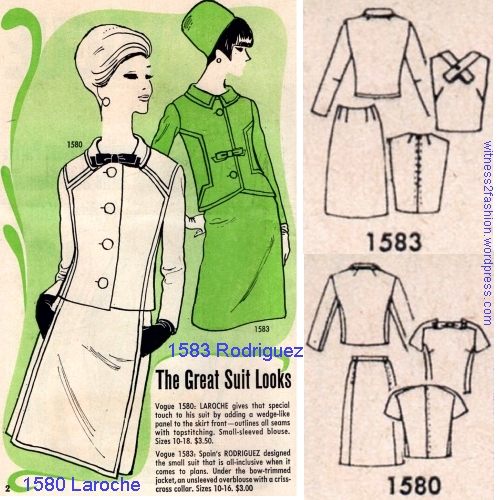
Vogue designer suits featured in April 1966. No. 1580, by Guy Laroche, and No. 1583, by Rodriguez. I think a very young woman would have been be more likely to choose No. 1583.
Both of these suits, on page 2 of the Vogue store flyer, are accented with top-stitching. The patterns include interesting blouses, to be worn outside the skirt, overlapping the skirt’s waist. This produced a “dress” look, especially when made from the same wool or linen as the skirt. [It was also chic to make the blouse in silk shantung the same color as the suit.]
The reason these suits look more youthful to me than #1581 is that the jackets reach only to the high hip — a style that worked well with late sixties’ skirts, which were getting shorter. The little bow at the neck of #1580 seems fussy to me — again, I could imagine an older woman wearing this suit; however, I wouldn’t call it “dowdy.” No. 1583 is more what a young woman might wear: the skirt has a “contour” waist, with no waistband — which was a youthful fashion, the opposite of the cinched-in waists of the 1950’s and early 60’s. The envelope shows it in pink, — very young looking. Young — and rich.
The sleeveless blouse of the Ricci suit (No. 1581) has shoulders which extend out to the point of the shoulder, but the Rodriguez blouse bares the shoulder — another look I associate with youthful women, like Audrey Hepburn.
Vogue Designer Suit Patterns 1576, 1575, and 1582, dated 1966.
On page 3, there are three great sixties’ suits, from Emilio Pucci, Federico Forquet, and the House of Ricci.
Notice the jacket length. The Forquet skirt, eased over the tummy instead of darted to fit, was called a “dirndl.” I made A-line dirndl skirts to wear with coordinating tops that just reached the high hip. The suit by Ricci also avoids fitting tightly. As the TV show Mad Men put it, this is “Jackie” versus “Marilyn.” [The “Jackie” type is not so desperate for love that she exposes her body to strangers, unlike the “Marilyn” type.]
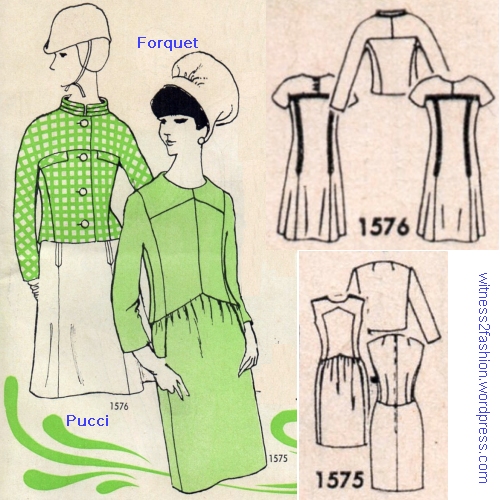
Vogue designer patterns 1575, by Forquet, and 1576, by Pucci. April, 1966. No. 1576 has a double line of topstitching, not solid black trim.
Both of these are jacket and dress combinations. The Forquet dress echoes the shaping of the jacket and suggests an hourglass shape without clinging tightly. It has a shaped, slightly dropped waist. The Pucci jacket is more sporty and shown with a “helmet” hat that evokes a riding outfit. The models on the envelope look young, not middle aged. Personally, I think jacket No. 1576 would work better with a dress in the darker color of the plaid jacket, but I’m not Pucci! 
Pucci’s stewardess uniforms for Braniff Airlines also had standing collars.
The pattern envelope for No. 1575 shows the [not very attractive] scarf. Click here. Sixties’ suits, like Nos. 1575 and 1581, often were accented with a large costume jewelry pin on the lapel or yoke.
Ricci Suit, Vogue Pattern 1582 from 1966
I love this suit. You got a lot for your $3.50 with this pattern: dress, jacket, and a wrap blouse. It’s elegant; the velvet collar makes it very dressy, and it skims the body — nothing overtly sexy about it. But it screams “self-confidence” and “self-respect.” In my twenties, I didn’t have any reason to wear such a beautiful suit, no matter how much I wanted one. It speaks of afternoon fund-raisers, museums, art galleries, fine restaurants, opera and ballet matinees; possibly cocktails at a hotel bar…. Not days spent working in a bank or teaching high school. Would it look good on a woman in her mid-twenties? Yes. Would it look equally good on a woman in her thirties? Her forties? Her sixties? Yes.
And now for something completely different….
Vogue “Special Design” Suit Pattern 6747
From the same Vogue pattern flyer, a suit without a designer label:
To my twenty-tear-old eyes, this suit screamed, “Middle aged. Long married. Dull.”
Yes, do “note the little belt at the sides of the jacket” — designed to make a woman with a thick waist look even more shapeless. I must have seen dozens of versions of this outfit made of polyester doubleknit. Even the blouse would make you look round-shouldered and dowager-humped; and those sleeves are the perfect length to make your arms look chubby and your bust look wider. The width of the skirt’s center panel is a lot less flattering than a single, central pleat would be. You would have to make this suit out of very fine quality wool, indeed, to give the impression of wealth and elegance. Even the pattern envelope, in color, can’t convince me that anyone but a middle-aged woman would want to wear it. It does look better with a straight skirt. The model wearing the black and white version seems to have white hair. (So do I, now. But this is about 1966. The aristocratic “Mrs. Exeter” never had to appear in this pattern!) You can read many entertaining posts about “Mrs. Exeter” at American Age Fashion, What Older Women Wore, 1900 to Now.
There’s not a hint of Carnaby Street or “the Youthquake” in Vogue 6747.

